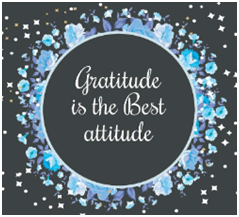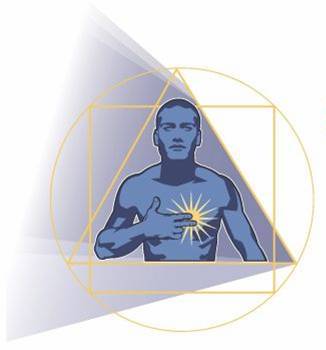By Robert Rudelic BS, NMT, MES

We have all heard from someone — mother, father, pastor, coach, etc. — that we should be grateful for what we have and that gratitude is a powerful tool in life but ….what does gratitude really mean?
Gratitude is a positive emotion that involves being thankful and appreciative and is associated with many mental and physical health benefits.
When you experience gratitude, you feel grateful for something or someone in your life and respond with feelings and actions of kindness, warmth, and other forms of generosity.
Most people want to feel good about how their life is going and behave in such a way that they continue to feel that way. So why don’t they, what is the biggest obstacle for a person to utilize gratitude in their lives?
A sense of entitlement is perhaps the greatest obstacle to gratitude and being grateful for all one has. “Research has shown that people who are ungrateful tend to have a sense of excessive self-importance, arrogance, vanity, and a high need for repeated admiration and approval,” writes Dr. Robert Emmons in his book Gratitude Works! July 1, 2018.
So, if you want more for your life, be happier, have better relationships, be more productive, build resilience and much, much more —
The Secret is > > > An Attitude of Gratitude!
“Acknowledging the good that you already have in your life is the foundation for all abundance.”
- Having Gratitude makes you happier
- Gratitude makes people like you
- Gratitude makes you healthier
- Gratitude boosts your career
- Gratitude strengthens your emotions
- Gratitude develops your personality
- Gratitude makes you less self-centered
- Gratitude can keep you away from the doctor
It’s common advice to create a gratitude journal and spend a few minutes each day reflecting on the things you are grateful for. Spending just a few minutes each day in this mindset will produce an overall happier and more satisfying mood. You’ll feel grateful more often and the intensity will be stronger and last longer. Gratitude is one of the most powerful tools in your emotional tool box. I believe being grateful in short spurts throughout the day is far more powerful and easier to do.
I also believe that being grateful is a mindset and a skill, and the more aware you are of things to be grateful for and express your gratitude in the moment, the faster you’ll become happier and more grateful.
Gratitude generates social capital: (the networks of relationships among people who live and work in a particular society, enabling that society to function effectively). In two recent studies with 243 total participants, those who were 10% more grateful than average had 17.5% more social capital! Research consistently shows important benefits related to social capital, such as individuals with higher levels of social capital being happier and finding better jobs. Research also shows that people report better health and increased levels of trust in a community as a result of their positive relationships. Having gratitude makes you nicer, more trusting, more social, and more appreciative. As a result, it can help you make more friends, deepen your existing relationships, and even improve your marriage.
Gratitude lowers cortisol, a stress hormone, in your body. Lowered cortisol levels help you avoid many physical and mental side effects of stress and improves overall physical health. Gratitude encourages pro-health behavior like exercising and paying attention to health risks. People who are grateful tend to sleep better and have fewer aches and pains. Expressing gratitude is associated with a host of mental and physical benefits. Studies have shown that feeling thankful can improve sleep, mood and immunity. Gratitude can also decrease depression, anxiety, difficulties with chronic pain and risk of disease. There is even reason to believe gratitude can extend your lifespan.
Gratitude makes you a more effective and positive leader or manager, helps you network, improves your decision making capabilities, increases your productivity, gain respect, and helps you attract accomplished mentors. As a result, gratitude helps you achieve your career goals, as well as making your workplace a more friendly and enjoyable place to be. Having a grateful mindset also changes biology. Positive acts benefit you by releasing oxytocin, a hormone that helps connect people. It is sometimes referred to as the love hormone. Those you connect with will also benefit from your kindness and appreciate the recognition of their efforts. Sharing kindness can make you healthier and happier.
Gratitude reduces feelings of envy, makes for happier memories, lets you experience good feelings, and helps you bounce back from stressful events. Gratitude is a way for you to appreciate what you have instead of always reaching for something new in the hopes it will make you happier or thinking you can’t feel satisfied until every physical and material need is met. Gratitude is the antidote for feeling inadequate and comparing your-self to others. Gratitude helps you focus on what you have instead of what you lack.
It really does, and in potentially life-changing ways. You automatically become more optimistic and less attracted to material things. Gratitude builds emotional resilience by helping you to see the positive things in life and replacing pessimistic thoughts with optimistic ones. The act of gratitude is the act of focusing on the good in life. If you perceive your current life to have more good, you will also believe your future life to have more good. Optimism is correlated with gratitude because those with an optimistic personality are biologically more likely to focus on the good than on the bad and rise above personal disappointment, stress and anxiety, etc. Gratitude greatly increases self-esteem. Research shows that people who are more grateful also tend to have higher self-esteem. When you are aware of how others treat you and the good things they do for you, you develop a stronger sense of your own value.
Gratitude is about acknowledging others and their acts of kindness, resulting in reduced self-focus. It’s most likely why grateful people are admired and respected so much—rather than being occupied with themselves all the time; they show care and interest toward others. Gratitude and humility go hand in hand; they are mutually reinforcing. Expressing gratitude induces humility, and humility increases your capacity for experiencing and conveying gratitude. The more grateful you are, the more likely you are to help others. As your cup overflows, you feel a natural urge to help others.
Gratitude can’t cure cancer but it can strengthen your physiological functioning. Positive emotions improve health unlike the known link between a negative mental state and physical suffering. In a doctor-patient relationship the patient’s belief makes a world of difference as to that person’s health. What a doctor says and what the patient believes may be more closely tied to the patient’s outcome than what the doctor does physically.
If a doctor is warning about possible negative side effects increases the likelihood of the patient experiencing pain or suffering, as research consistently suggests will happen, the leading culprit is the patient’s mental state. Fear or a deep pessimism that they won’t get better can be the underlying enemy to health. The flip-side of the belief coin is the health benefit linked to a positive mental state.
According to a landmark review, positive expectations are associated with better health. Science Daily reported that the reviewers of more than 160 studies on the mind-body connection were shocked by the consistency they saw in the data. Over and over the evidence showed that a person’s positive beliefs are a strong influence for good on their health.
If the root driver of the body’s health, good or bad lies in what’s occupying your mind, it’s important to be much more alert to what’s tugging at you for attention. if you want to improve your health, improve your mind.
Gratitude is a positive emotion. It’s no far stretch that some of the benefits like better coping & management of terminal conditions, faster recovery from certain medical procedures, positive changes in immune system functioning, more positive health behavior, apply to gratitude as well.
In fact, some recent science shows just that — those who engage in gratitude practices have been shown to feel less pain, go to the doctor less often, have lower blood pressure, and be less likely to develop a mental disorder.
“Gratitude is the healthiest of all human emotions. The more you express gratitude for what you have, the more likely you will have even more to express gratitude for.”

• Attitude •
There once was a woman who woke up one morning, looked in the mirror
and noticed she had only three hairs on her head.
‘Well,’ she said, ‘I think I’ll braid my hair today.’
So she did and she had a wonderful day.
The next day she woke up, looked in the mirror
and saw that she had only two hairs on her head.
‘Hmm,’ she said, ‘I think I’ll part my hair down the middle today.’
So she did and she had a grand day.
The next day she woke up, looked in the mirror and noticed
that she had only one hair on her head.
‘Well,’ she said, ‘today I’m going to wear my hair in a ponytail.‘
So she did, and she had a fun, fun day.
The next day she woke up, looked in the mirror and
noticed that there wasn’t a single hair on her head.
‘Yay!’ she exclaimed. ‘I don’t have to fix my hair today!’
• Attitude Is Everything•
Be kinder than necessary – everyone you meet is fighting some kind of battle.
• The Gratitude Exercise Simplified •
Each day, when reflecting on the things you are grateful for; sit quietly and start tapping. Tap each point for 7-10 seconds then change to the next point and keep tapping throughout the exercise. While tapping, start with one thing you are grateful for, state it then state why you are so grateful and elaborate. When finished with the first thing you are grateful for, complete it with a fist pump and passionately say thank you! thank you! thank you! Then move to the next thing you are grateful for. Do this gratitude exercise for 10-15 minutes then spend a few minutes reflecting on what you just did.
This exercise can be done anywhere, anytime you are feeling grateful.





For more information, visit our PowerTapping page.
San Francisco, CA 94107
Contact Us: www.RobertRudelic.com/contact
E-Mail: support@RobertRudelic.com

By Robert Rudelic BS, NMT, MES
What’s going on in our world today is often described as "America’s Anger Epidemic." The list of reasons for all this anger is long but some state at the top of the list is; financial uncertainty, working long hours, (on average about one month more now than they did in the 1970s and with less vacation), opposing views about politics, religion, or tastes in music, cheering for a favorite sports team, the list of reasons for having so much anger is long, but the real problem lies in the inability to be emotionally composed and to “disagree agreeably” as my dad used to say.
What has you seeing red? Maybe it’s getting cut off in traffic, or being verbally attacked. For one guy seen on a viral video, he threw a tantrum over a city street trombone player. I guess he didn’t like the tune!
There are meltdowns happening all around us, whether it happens to you personally or you see it on TV or hear about it on the radio, or if you log in to any social media platform, much of what you see or read is negative, hate filled meltdowns. A recent study from the USA Today found 60 percent of Americans report feeling angry or irritable. That is up from 50 percent when a similar poll was taken in 2011.
Dr. Vince Berger states, “We know what anger is because we have all experienced it, whether as a fleeting annoyance or as full-blown rage.”
In general, we may become angry or frustrated whenever we are not able to achieve a goal. Life is full of frustrations from minor irritations to something really big. When we use our frustration and anger to motivate us to change something in our life, anger and frustration end up being good and helpful. But for many people anger and frustration result in irritability, rage, wrath, stress, resentment, loss of confidence, depression and other negative behaviors. While anger and frustration are not the same, the distinctions between them are lost and meaningless.
Understanding Anger and Rage
Anger is an emotional response to a real, felt or imagined grievance. It may have its roots in a past or present experience, or it may be in anticipation of a future event. Anger is invariably based on the perception of threat or a perceived threat due to a conflict, injustice, negligence, humiliation and betrayal among others.
Many words in our vocabulary describe various forms of anger that differ primarily by their intensity of passion and arousal. A partial list includes: irritation, frustration, annoyance, miffed, sulking, offended, indignation, exasperation, incensed, pissed, outrage, wrath, rage, fury, ferocity, and livid.
Anger can be an active or a passive emotion. In case of "active" emotion the angry person lashes out verbally or physically at an intended target. When anger is a passive emotion it’s characterized by silent sulking, passive-aggressive behavior, and hostility.
Anger can be caused by both external and internal events. You could be angry at a specific person or event (a traffic jam, a canceled event), or your anger could be caused by worrying or brooding about your personal problems. Memories of traumatic or enraging events can also trigger angry feelings.
Anger is a completely normal, usually healthy, human emotion. But when it gets out of control and turns destructive, it can lead to problems at work, in your personal relationships, and in the overall quality of your life. And it can make you feel as though you’re at the mercy of an unpredictable and powerful emotion.
Physiological Aspects of Anger
Like other emotions, anger is accompanied by physiological and biological changes. When you get angry, your heart rate and blood pressure go up, as do the levels of your energy hormones, adrenaline and noradrenaline, your rate of breathing increases and your body’s muscles tense up.
While anger has a physiological preparation phase during which the body resources are mobilized for a fight, it also has a wind-down phase as well. The body starts to relax back towards its resting state when the target of the anger is no longer accessible or an immediate threat. It is difficult to relax from an angry state very quickly. The adrenaline-caused arousal that occurs during anger lasts a very long time (many hours, sometimes days), and lowers the anger threshold, making it easier for the person to get angry again later on. It takes a rather long time for the body to return to the resting state.
Expressing Anger
People use a variety of both conscious and unconscious processes to deal with their angry feelings. Expressing your angry feelings can be done in violent destructive ways or in an assertive, but non-aggressive, manner.
Anger can be suppressed, and then converted or redirected. This happens when you hold in your anger, stop thinking about it, and focus on something positive. The aim is to inhibit or suppress your anger and convert it into more constructive behavior. The danger in this type of response is that if it isn’t allowed outward expression, your anger can turn inward on yourself. Anger turned inward may cause hypertension, high blood pressure, or depression. Unexpressed anger can create other problems. It can lead to pathological expressions of anger, such as passive-aggressive behavior (getting back at people indirectly, without telling them why, rather than confronting them head-on) or a personality that seems perpetually cynical and hostile. People who are constantly putting others down, criticizing everything, and making cynical comments haven’t learned how to constructively express their anger.
Anger can make us blind to the truth and unable to accept what’s sensible and correct. When anger is the primary emotion being felt, we become less able to think and act rationally and in some cases, even our senses do not work properly because of extreme anger.
Anger is often followed by depression. When we feel particularly irate, we tend to express ourselves verbally or physically. Afterwards, when we recognize such outburst as atypical of ourselves and we end up feeling depressed with the reality of what we have just done.
Anger Addiction
We all know someone who seems to always be involved in a conflict. They seem to love to argue, are always itching for a fight, or purposely push all the right buttons to get a rise out of those around them. What makes some people so constant in their anger? The answer may be biological. When we are in the middle of conflict, our fight or flight instinct kicks in to help us respond to the perceived danger. This response is initiated by the release of the stress hormone cortisol by the adrenal gland.
While cortisol is important to a healthy system, it can also produce a chemical “high” that can be addictive. Normally, cortisol lowers once danger is gone but if a person constantly exposes themselves to high stress situations such as those caused by anger and conflict, their system never completely processes the cortisol. This causes the biological system to remain polluted, so to speak, with the excess chemical. Once we become more and more exposed to high levels of cortisol caused by increased conflict and stress, “like a drug addict, (we) need a bigger fix all the time.
The Solution –
Overcoming the Addiction to Anger
We are taught in our society that anger is bad therefore after we calm-down, we feel bad in some way or feel guilty for getting angry in the first place. Women are particularly affected by anger – for many its scares them because of the loss of control, it’s also unbecoming and can be embarrassing.
The 3 keys to Eliminating Anger
- Recognize why you got angry and forgive yourself. I’ve developed a simple tool to do that in three minutes or less. Journal about what triggered you. Getting it down on paper will broaden your understanding of the issues involved and open up some avenues to respond differently in the future.
- You must desensitize yourself to lower the intensity of your response by “tapping out” why you’re angry and why this response no longer works for you. Eventually this erases the trigger forever.
- Put in its place a constructive, emotionally satisfying response by “tapping in” how you’ll respond in the future to any provocations. Do this until on a scale of 1-10 you believe it between 8-10.

Anger as an addiction is not well understood.
Dr. Candice Pert in her book “The Molecules of Emotion” wrote that emotions are peptides (molecules). When you’re triggered the body produces these molecules which are then released into the body where they attach to receptors on the cells and trigger the feeling of the emotion. Each time you’re triggered more receptors are made that need to be filled or satisfied just like any chemical addiction. The brain goes about filling that need by setting up situations that cause you to be triggered.
So when you see people getting so easily triggered, they are not in control, they are just acting out while under the influence of the molecules (drug) of Anger.
Like any addiction you have to be vigilant and address anger every time it occurs. Get good at knowing when to use anger to your advantage and when to get rid of it. Having the tools to handle it effectively is what is most important and that’s what I’ve developed.



For more information, visit our PowerTapping page.
San Francisco, CA 94107
Contact Us: www.RobertRudelic.com/contact
E-Mail: support@RobertRudelic.com


